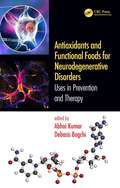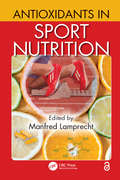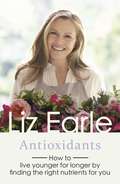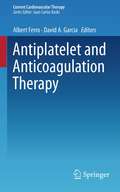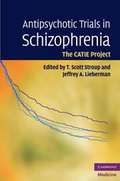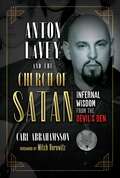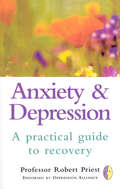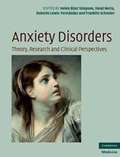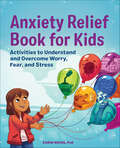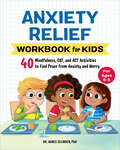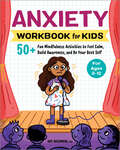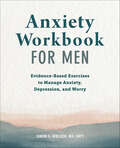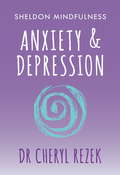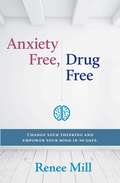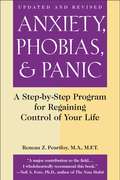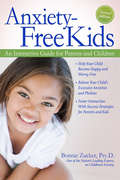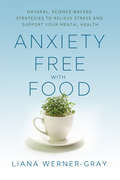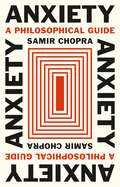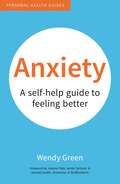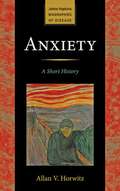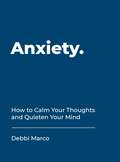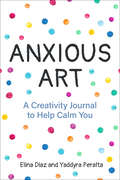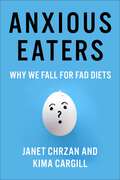- Table View
- List View
Antioxidants and Functional Foods for Neurodegenerative Disorders: Uses in Prevention and Therapy
by Debasis Bagchi Abhai KumarNeurodegenerative diseases, including Alzheimer’s and Parkinson’s disease, are a growing problem across the world’s aging population. Oxidative stress in the brain plays a central role in a common pathophysiology of these diseases. This book presents scientific research on the potential of antioxidant therapy in the prevention and treatment of neurodegenerative disorders.This book outlines the roles of oxidative stress and diabetes mellitus in neurodegeneration, describes the molecular mechanisms of neurodegenerative disorders including the roles of environmental pollutants and inflammatory responses, and explores mitochondrial dysfunction. It then describes the protective abilities of antioxidants – including vitamin D, tocotrienol and coenzyme Q10 – against neurodegeneration. The book demonstrates the therapeutic potential of ketogenic diets, and highlights the roles of medicinal plants, phytopharmaceuticals, traditional medicines and food nutrients in neuroprotection.Key Features: Explains damage caused by numerous neurodegenerative disorders and the possible protection offered by antioxidants and functional foods. Describes molecular mechanisms of neurodegeneration by oxidative stress, advancing age, diabetes and mitochondrial dysfunctions. Demonstrates protection offered by nutraceuticals, antioxidants, botanical extracts and functional foods. The book contains twenty-three chapters divided into six sections written by leading researchers. This book is essential reading for health professionals, dietitians, food and nutrition scientists and anyone wanting to improve their knowledge of etiology of neurodegenerative diseases.
Antioxidants in Sport Nutrition
by Manfred LamprechtAntioxidant use in sports is controversial due to existing evidence that it both supports and hurts athletic performance. This book presents information on antioxidants, specifically for athletes, and their roles in sports nutrition. It stresses how antioxidants affect exercise performance, health, and immunity. Chapters cover oxidative stress; basic nutrition for athletes; major dietary antioxidants; sports supplements; performance/adaptation to exercise; antioxidants role in health and immunity; reviews on vitamins C, E, beta-carotene, and minerals in sports nutrition; and roles polyphenols play in high-performance sport.
Antioxidants: How to live younger for longer by finding the right nutrients for you (Wellbeing Quick Guides)
by Liz EarleLiz Earle explains how these nutrients protect against cancer, heart disease and ageing and shows you how supplements and delicious recipes can bring them into your diet today.Bestselling beauty and wellbeing writer Liz Earle's fully revised and updated quick guide to antioxidants, including:- The science behind antioxidants and how they work- Their effect on ageing and age-related disorders- The dangers of free radicals and how to avoid them- Easy ways to add antioxidant nutrients into your diet- A sensible and safe guide to choosing your supplements
Antiplatelet and Anticoagulation Therapy (Current Cardiovascular Therapy)
by Albert Ferro David A. GarciaThis title will be presented as highly practical information pn pharmaceutical antiplatelet and anticoagulation therapy, written in a quick-access, no-nonsense format. The emphasis will be on a just-the-facts clinical approach, heavy on tabular material, light on dense prose. The involvement of the ISCP will ensure that the best quality contributors will be involved and establish a consistent approach to each topic in the series. Each volume is designed to be between 120 and 250 pages containing practical illustrations and designed to improve understand and practical usage of cardiovascular drugs in specific clinical areas.
Antipsychotic Trials in Schizophrenia
by T. Scott Stroup Jeffrey A. LiebermanAntipsychotic medications are a key treatment for schizophrenia, and sales of antipsychotic drugs approach $20 billion per year, with fierce marketing between the makers of the drugs.
Anton LaVey and the Church of Satan: Infernal Wisdom from the Devil's Den
by Carl Abrahamsson• Includes never-before-published material from LaVey, including transcripts from his never-released &“Hail Satan!&” video • Shares in-depth interviews with intimate friends and collaborators, including LaVey&’s partner Blanche Barton, his son Xerxes LaVey, and current heads of the Church of Satan Peter Gilmore and Peggy Nadramia • Provides inside accounts of the Church of Satan and activities at the Black House, personal stories and anecdotes from the very colorful life of the Black Pope, and firsthand explanations of key principles of LaVey&’s philosophy With his creation of the infamous Church of Satan in 1966 and his bestselling book The Satanic Bible in 1969, Anton Szandor LaVey (1930-1997) became a controversial celebrity who basked in the attention and even made a successful career out of it. But who was Anton LaVey behind the public persona that so easily provoked Christians and others intolerant of his views? One of privileged few who spent time with the &“Black Pope&” in the last decade of his life, Carl Abrahamsson met Anton LaVey in 1989, sparking an &“infernally&” empowering friendship. In this book Abrahamsson explores what LaVey was really about, where he came from, and how he shaped the esoteric landscape of the 1960s. The author shares in-depth interviews with the notorious Satanist&’s intimate friends and collaborators, including LaVey&’s partner Blanche Barton, his son Xerxes LaVey, current heads of the Church of Satan Peter Gilmore and Peggy Nadramia, occult filmmaker Kenneth Anger, LaVey&’s personal secretary Margie Bauer, film collector Jack Stevenson, and film historian Jim Morton. Abrahamsson also shares never-before-published material from LaVey himself, including discussions between LaVey and Genesis P-Orridge and transcripts from LaVey&’s never-released &“Hail Satan!&” video. Providing inside accounts of the Church of Satan and activities at the Black House, this intimate exploration of Anton LaVey reveals his ongoing role in the history of culture and magic.
Anxiety & Depression: A Practical Guide to Recovery
by R G PriestFeelings of anxiety and depression confront us all from time to time, and can vary in their severity. Recognising the symptoms, understanding their causes and effects, and knowing what help is available can be very reassuring and help overcome the condition. Professor Robert Priest has written this book especially to provide help for those feeling anxious and depressed. In particular he covers the practical self-help methods to reduce stress and offers an explanation of the causes and effects of anxiety and depression. The book provides up to date information on the professional help available and details the action and side-effects of medications.
Anxiety . . . I'm So Done with You: A Teen's Guide to Ditching Toxic Stress and Hardwiring Your Brain for Happiness
by Jodi AmanA Practical Guide with Activities to Help You Break Out of Depression and Anxiety Are you feeling stressed out, anxious, and alone? Do you stay up at night wondering if it will all work out? And how will you handle it when it doesn&’t? Do you double down on your efforts to be smart enough, cool enough, able enough, only to make everything worse? Is anxiety sucking the life out of you? If you are familiar with these feelings—and want a way out—this book is for you. Teenagers, especially, are supposed to be carefree and energetic, but today&’s Gen Z is anything but free. We are exposed to political conflict, environmental disaster, and community violence daily. Life seems so out of control! In addition, competition encouraged by social pressures and social media has damaged our self-confidence, making our culture a petri dish where low self-esteem, anxiety, and depression grow. This workbook shows you the way out. Learn to build trust in your skills and abilities so you can create your own life instead of being a passive recipient of it. Learn how to get rid of anxiety, let go of perfectionism, and experience lasting happiness. Learn the Biology behind Anxiety—What It Is and What It Isn&’tIdentify the Lies that Anxiety Tells YouActivate Your Own Agency—Your Confidence, Motivation, and Unique SkillsEmbrace an Attitude of Self-AcceptancePractice Happy Habits Daily
Anxiety Disorders: Theory, Research and Clinical Perspectives
by Helen Blair Simpson Yuval Neria Roberto Lewis-Fernández Franklin SchneierAnxiety disorders are amongst the most common of all mental health problems. Research in this field has exploded over recent years, yielding a wealth of new information in domains ranging from neurobiology to cultural anthropology to evidence-based treatment of specific disorders. This book offers a variety of perspectives on new developments and important controversies relevant to the theory, research, and clinical treatment of this class of disorders. Clinicians will find reviews of state-of-the-art treatments for panic disorder, social anxiety disorder, phobias, obsessive-compulsive disorder, generalized anxiety disorder, and post-traumatic stress disorder, as well as controversies over diagnostic and treatment issues. Researchers will find in-depth consideration of important selected topics, including genetics, neuroimaging, animal models, contemporary psychoanalytic theory, and the impact of stressors. This book illustrates the enormous advances that have occurred in anxiety research and describes the evolving multi-disciplinary efforts that will shape the future of the field.
Anxiety Relief Book for Kids: Activities to Understand and Overcome Worry, Fear, and Stress
by Ehrin WeissHelp kids find freedom from anxiety with engaging activities for ages 8 to 12Dealing with anxiety is tough, but with the right tools, kids can learn how to handle it in a healthy way so they can get back to the fun of being a kid. Anxiety Relief Book for Kids is the perfect introduction to anxiety books for kids, full of information and exercises to help kids build skills for finding peace and facing their fears with confidence.This standout among anxiety books for kids includes:An understanding of worries—Unlike many other anxiety books for kids, this one teaches them where worries come from, what they feel like, and ways to conquer them.Real-life solutions—Kids will learn to notice when their worries are causing problems, recognize what their feelings are trying to tell them, and come up with ideas for making their worries feel smaller.A range of fun activities—Writing, drawing, and meditating will help kids calm their bodies and quiet their thoughts.Proven strategies—Kids can start finding relief through exercises based in mindfulness, cognitive behavioral therapy, and exposure therapy.Help kids show their worries who's boss with help from this empowering choice in anxiety books for kids.
Anxiety Relief Workbook for Kids: 40 Mindfulness, CBT, and ACT Activities to Find Peace from Anxiety and Worry (Health and Wellness Workbooks for Kids)
by Dr. Agnes Selinger PhDAnxiety-busting tools for kids ages 6 to 9Being young doesn't stop kids from worrying. This anxiety workbook for kids, created by a clinical psychologist, is full of fun exercises designed to help kids learn how to work through feelings of discomfort or worry. Each of the activities features kid-friendly instructions, helping them understand both what they need to do and how it will help them feel better.This anxiety workbook for kids features:A variety of exercises—Kids will find new ways to soothe child anxiety as they draw, take quizzes, practice breath work, and more.Evidence-based approaches—All of the exercises are rooted in proven anxiety treatment methods, like CBT, ACT, and mindfulness.Fun presentation—Playful language and colorful pictures help kids engage with the material, making it easy for them to learn.Teach kids how to deal with some of their toughest emotions using this anxiety relief workbook for kids.
Anxiety Workbook for Kids: 50+ Fun Mindfulness Activities to Feel Calm, Build Awareness, and Be Your Best Self (Health and Wellness Workbooks for Kids)
by Amy Nasamran PhDHelp kids find confidence and calm with this anxiety workbook for ages 8-12Making new friends, studying for a big test, or trying something new can make kids feel anxious, but the Anxiety Workbook for Kids teaches them simple ways to work through anxious feelings with mindfulness. Through 50+ anxiety-reducing activities, kids will learn techniques like deep breathing and positive thinking, so they can stay in the moment and take on any challenge!Get more than other books about anxiety for kids:What is anxiety, anyway? —The friendly language in this kids' anxiety book makes it simple for them to understand what anxiety feels like, where it comes from, and how these exercises can help them feel better.For anxieties big and small—Help your child learn how to keep their cool in through the different kinds of anxiety kids face, whether it's moving to a new home, coping with loss, or getting called on in class.56 hands-on mindfulness activities—With this anxiety activity book, kids can write down their feelings, try easy meditations, explore a growth mindset, and more.Show kids how to build an anxiety toolkit of mindfulness skills that will last a lifetime.
Anxiety Workbook for Men: Evidence-Based Exercises to Manage Anxiety, Depression, and Worry
by Simon G. NiblockTackle anxiety and take control of your life with practical strategies for menDiscover how you can better cope with and manage your stress and anxiety with this workbook written just for men. You'll find key insights into the unique ways anxiety manifests in men, along with the support you need to overcome the challenges men face—whether it's at home, work, or with friends and family. This workbook provides proven exercises to help you better understand your anxiety, identify its triggers, and find ways to deal with it.This guy-focused workbook features:Advice for men—Get guidance that takes into account the specific ways men cope with anxiety and the societal pressures they face when encountering it.Evidence-based tools—Learn simple, proven techniques for mitigating anxiety through exercises based on mindfulness, meditation, acceptance and commitment therapy, and cognitive behavioral therapy.Anxiety-busting tips—Find new ways to confront both chronic and moment-to-moment anxiety through journaling, exploratory quizzes, charting, and various thought exercises.This understanding workbook gives you the resources to build your anxiety-management toolbox.
Anxiety and Depression: Sheldon Mindfulness
by Cheryl RezekThis book provides an introduction to mindfulness, the concepts and theory behind it and how it can help manage not only anxiety, but a number of physical and emotional issues. It includes step-by-step practices to manage your anxiety and depression, and links to an audio download of guided meditations. Topics include:Understanding anxiety and mindfulnessNo magic pillsHow did I get to be like this?Anxiety and depression in contextThe stress responseBreaking the cycleEffects of mindfulness on the brainMoving forwards – take care
Anxiety and Depression: Sheldon Mindfulness (Sheldon Mindfulness Ser.)
by Cheryl RezekThis book provides an introduction to mindfulness, the concepts and theory behind it and how it can help manage not only anxiety, but a number of physical and emotional issues. It includes step-by-step practices to manage your anxiety and depression, and links to an audio download of guided meditations. Topics include:Understanding anxiety and mindfulnessNo magic pillsHow did I get to be like this?Anxiety and depression in contextThe stress responseBreaking the cycleEffects of mindfulness on the brainMoving forwards ? take care
Anxiety free, Drug Free: Change Your Thinking And Empower Your Mind In 90 Days
by Renee MillA Simon & Schuster eBook. Simon & Schuster has a great book for every reader.
Anxiety, Phobias, and Panic: A Step-by-Step Guide for Regaining Control of Your Life
by Reneau Z. PeurifoyIn this classic guide, expert Reneau Peurifoy shows readers how to understand and overcome all types of anxiety-related disorders. Anxiety is an unpleasant, though mostly unavoidable, aspect of modern life-but for many, normal anxiety can become something far more serious and debilitating. Now, in this updated and revised edition of Anxiety, Phobias & Panic, readers will learn how their condition developed and how to overcome their anxiety-related problems. Areas covered include: uncovering the causes of anxiety, building stress tolerance, identifying and correcting harmful modes of thinking, relaxation techniques, tools for managing anxiety, and much more.
Anxiety-Free Kids: An Interactive Guide for Parents and Children
by Bonnie ZuckerAnxiety-Free Kids (2nd ed.) offers parents strategies that help children become happy and worry free, methods that relieve a child's excessive anxieties and phobias, and tools for fostering interaction and family-oriented solutions. Using a unique companion approach that offers two books in one-a practical, reader-friendly book for parents and a fun workbook for kids-this solutions-oriented guide utilizes the cognitive-behavioral approach to therapy and integrates the parent in the child's self-help process. Research has shown that if left untreated, children with anxiety disorders are at higher risk to perform poorly in school, to have less-developed social skills, and to be more vulnerable to substance abuse. Covering the six most commonly occurring anxiety disorders-generalized anxiety, separation anxiety, specific phobias, social phobias, panic disorder, and obsessive-compulsive disorder-this book gives kids and parents successful strategies for achieving relaxation, conquering worries, challenging faulty thinking patterns, developing positive self-talk, and facing one's fears.
Anxiety-Free with Food: Natural, Science-Backed Strategies to Relieve Stress and Support Your Mental Health
by Liana Werner-Gray&“Liana&’s recipes are packed with antioxidants, magnesium, and healthy omega fats to help reduce stress and defeat anxiety.&” — Mark Hyman, M.D., New York Times best-selling author of Food: What the Heck Should I Eat?Release stress and anxiety naturally with this simple yet comprehensive nutrition guide that supports your mental health from Liana Werner-Gray, author of Cancer-Free with Food.Eat your way to calm . . .If you're feeling anxious, stressed, or depressed, you're not alone. The world may be in turmoil-but inside, we can feel unwavering peace. We can support our mental and physical health by avoiding anxiety-inducing ingredients and choosing foods and supplements that support our microbiome, address nutritional deficiencies, and balance our hormones.Liana Werner-Gray, nutritionist and author of The Earth Diet and Cancer-Free with Food, offers this simple guide to all the scientifically backed, nutrient-rich foods and supplements you need to support your emotional wellness. She offers 100+ delicious gluten-free, soy-free, refined sugar-free, and dairy-free recipes that both nourish the body and support optimal brain function. With Liana's easy strategies based on nutritional neuroscience, you'll feel empowered to take control of your mental well-being.Remember, life is meant to be enjoyed. Let your first step toward an anxiety-free life start with your next meal!
Anxiety: A Philosophical Guide (Moral Psychology Of The Emotions Ser.)
by Samir ChopraHow philosophy can teach us to be less anxious about being anxious by understanding that it&’s an essential part of being humanToday, anxiety is usually thought of as a pathology, the most diagnosed and medicated of all psychological disorders. But anxiety isn&’t always or only a medical condition. Indeed, many philosophers argue that anxiety is a normal, even essential, part of being human, and that coming to terms with this fact is potentially transformative, allowing us to live more meaningful lives by giving us a richer understanding of ourselves. In Anxiety, Samir Chopra explores valuable insights about anxiety offered by ancient and modern philosophies—Buddhism, existentialism, psychoanalysis, and critical theory. Blending memoir and philosophy, he also tells how serious anxiety has affected his own life—and how philosophy has helped him cope with it.Chopra shows that many philosophers—including the Buddha, Kierkegaard, Nietzsche, Freud, and Heidegger—have viewed anxiety as an inevitable human response to existence: to be is to be anxious. Drawing on Karl Marx and Herbert Marcuse, Chopra examines how poverty and other material conditions can make anxiety worse, but he emphasizes that not even the rich can escape it. Nor can the medicated. Inseparable from the human condition, anxiety is indispensable for grasping it. Philosophy may not be able to cure anxiety but, by leading us to greater self-knowledge and self-acceptance, it may be able to make us less anxious about being anxious.Personal, poignant, and hopeful, Anxiety is a book for anyone who is curious about rethinking anxiety and learning why it might be a source not only of suffering but of insight.
Anxiety: A Self-Help Guide to Feeling Better (50 Things Ser.)
by Wendy GreenIn Anxiety: A Self-Help Guide to Feeling Better, Wendy Green explains how psychological, genetic and dietary factors can contribute to anxiety and offers practical advice and a holistic approach to help you deal with the symptoms, including simple dietary and lifestyle changes and DIY complementary therapies.
Anxiety: A Short History
by Allan V. HorwitzMore people today report feeling anxious than ever before—even while living in relatively safe and prosperous modern societies. Almost one in five people experiences an anxiety disorder each year, and more than a quarter of the population admits to an anxiety condition at some point in their lives. Here Allan V. Horwitz, a sociologist of mental illness and mental health, narrates how this condition has been experienced, understood, and treated through the ages—from Hippocrates, through Freud, to today. Anxiety is rooted in an ancient part of the brain, and our ability to be anxious is inherited from species far more ancient than humans. Anxiety is often adaptive: it enables us to respond to threats. But when normal fear yields to what psychiatry categorizes as anxiety disorders, it becomes maladaptive. As Horwitz explores the history and multiple identities of anxiety—melancholia, nerves, neuroses, phobias, and so on—it becomes clear that every age has had its own anxieties and that culture plays a role in shaping how anxiety is expressed. -- Peter Conrad, Brandeis University
Anxiety: How to Calm Your Thoughts and Quieten Your Mind
by Debbi MarcoLife’s journey is not always smooth sailing, but there are ways of charting your own course. This compact book is packed with simple but effective tips and advice to ease your mind in times of turbulence, and help you find calm in every situation.
Anxious Art: A Creativity Journal to Help Calm You
by Yaddyra PeraltaDecompress Your StressAnxious Art is for readers and doodlers seeking relief from anxiety and stress through meditative, creative processes.What if we took our stress and used it to create art that brings us peace?A 2016 study at Drexel university that examined the effects of creative activity on reducing levels of the stress hormone cortisol discovered that “45 minutes of art making…resulted in statistically significant lowering of cortisol levels.” We all know cortisol is the stress hormone, so grab a pen or pencil and let the meditations and writing prompts in this mindfulness journal take you on a calming journey to a healthier, happier mind.T.S. Eliot once said, “Anxiety is the handmaiden of creativity,” but if he had this creative journal during times of worry, he surely would have said creativity was the handmaiden to peace. With this friendly, calming companion, you will find that you are much more present in the here and now.A unique guided journal that will calm and inspire: When used as self-expression, creativity can allow us to take part in what psychologists call “sublimation,” or the transformation of negative or socially unacceptable impulses into socially acceptable or even beautiful creations. Anxious Art offers inventive prompts, art projects, and affirmations to inspire artistic activities that distract from feelings of distress and anxiety. As you experience this transformative guided journal, you will work with:Lyrical affirmations that build self-confidence and reduce fearTherapeutic writing exercises that root you in the present and spark joyDoodling that calms your emotionsGuided breathing exercises that bring you into the present momentFans of Wreck This Journal, Tiny Buddha’s Worry Journal, or I Am Her Now, will love the calming benefits of Anxious Art.
Anxious Eaters: Why We Fall for Fad Diets (Arts and Traditions of the Table: Perspectives on Culinary History)
by Janet Chrzan Kima CargillWhat makes fad diets so appealing to so many people? How did there get to be so many different ones, often with eerily similar prescriptions? Why do people cycle on and off diets, perpetually searching for that one simple trick that will solve everything? And how did these fads become so central to conversations about food and nutrition?Anxious Eaters shows that fad diets are popular because they fulfill crucial social and psychological needs—which is also why they tend to fail. Janet Chrzan and Kima Cargill bring together anthropology, psychology, and nutrition to explore what these programs promise yet rarely fulfill for dieters. They demonstrate how fad diets help people cope with widespread anxieties and offer tantalizing glimpses of attainable self-transformation. Chrzan and Cargill emphasize the social contexts of diets, arguing that beliefs about nutrition are deeply rooted in pervasive cultural narratives. Although people choose to adopt new eating habits for individual reasons, broader forces shape why fad diets seem to make sense.Considering dietary beliefs and practices in terms of culture, nutrition, and individual psychological needs, Anxious Eaters refrains from moralizing or promoting a “right” way to eat. Instead, it offers new ways of understanding the popularity of a wide range of eating trends, including the Atkins Diet and other low- or no-carb diets; beliefs that ingredients like wheat products and sugars are toxic, allergenic, or addictive; food avoidance and “Clean Eating” practices; and paleo or primal diets. Anxious Eaters sheds new light on why people adopt such diets and why these diets remain so attractive even though they often fail.
